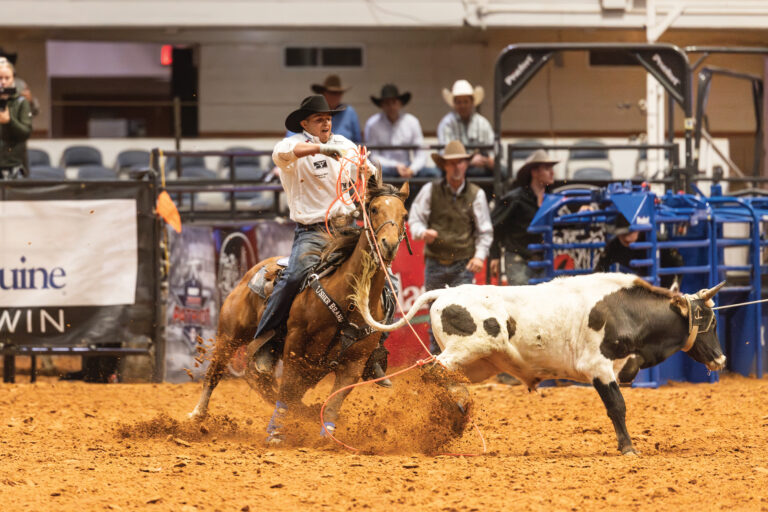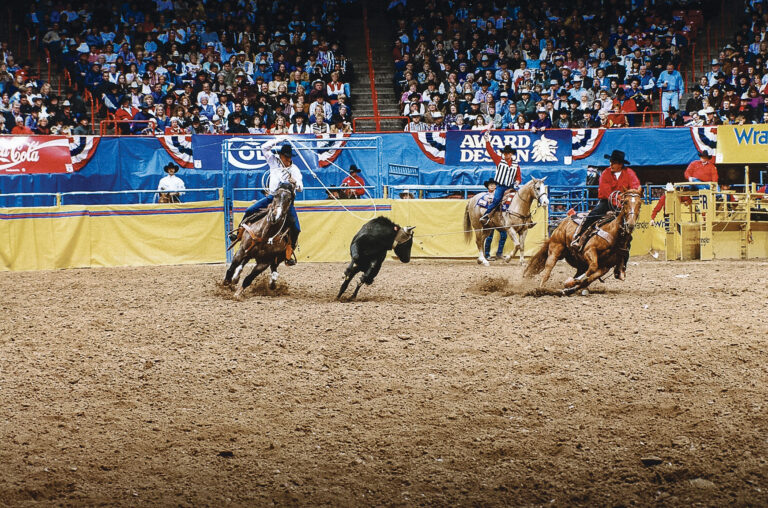Talking about loop size is one of the fundamental conversations all team ropers have. As with about anything we do when we rope, loop size is ultimately a matter of personal preference and what works for each individual roper. What works for me might not work for you.
I try not to be dead set on teaching people the way I do things for that very reason. I used to be more adamant about doing everything “the right way.” While there are basic fundamentals that are important to successful roping, each of us develops our own style. Roping’s not like The Ten Commandments, where you have to do things a certain way.
I adjust the size of my loop based on what I’m trying to do and a few key factors. Am I trying to be fast at a rodeo or to try and win a round at a roping? Am I roping my first one in a five-steer average? How big are the steer’s horns?
Read: Tricks of the Trade: Keeping Your Loop on Smaller Horned Cattle
If I’m competing in a multi-round event, I’m going to be a little bit more conservative and ride my horse a little closer. I’m going to try and get that steer on a tight rope, and give my heeler a really good handle. I’ll most likely start with a smaller loop. If you run up close to the steer and your loop’s too big, there will be more slack to deal with. Having steers on a longer rope also makes it harder to control the steer for your heeler.
The size of loop you use is insurance that you can cover the base of the horns. Ideally, the perfect-sized loop would be big enough to go around the steer’s horns with about an inch extra on each side. Nobody’s that precise, so you need to have your loop a little bigger to make sure it’s enough.
Do remember that if you get your loop too big, you won’t be able to pull all the slack out of it. I see a lot of headers make the mistake of not having the rope tight around the steer’s horns before they go left. When you do that, you jerk the heck out of that steer, and the result is a wild handle for your heeler. You’re not going to get a smooth corner, and there will be a lot of whip.
I see a lot of lower-numbered ropers who tend to start with a bigger loop than they need. To me, it’s easier to start with a smaller loop and feed it accordingly. It’s easier to get your rope up and your swing going with a smaller loop, then you can adjust it to fit whatever steer you’ve drawn.
If you start off with a big old loop and draw a really slow steer, you almost need to be able to reach, so you don’t have a bunch of extra rope out there. You need that distance to take up that slack.
A lot of people don’t like slow cattle, which is what they usually rope in the lower-numbered ropings. The reason they don’t like slow steers is what we’re talking about here. They preset their loop, and don’t adjust for the steer they’ve drawn and the scenario they’re roping in.
Playing with loop size is something people can practice on the dummy. I’ve noticed so many people make the same mistakes when they rope the dummy. They stand back if their loop’s too big. I can typically tell if people don’t like slow steers by the position they rope the dummy from. They look at me like I’m a psychic, but it’s pretty simple, really. They get good at roping the dummy from a certain spot. If you try to move them up closer, they have a tough time making the adjustment.
The “tell” on your loop being too small is if it comes up short of your target. When that happens, you either need to ride your position a little closer, start with a bigger loop or feed your loop until it’s big enough.
When I’m trying to be fast, I start with a bigger loop and with more spoke. As that loop’s getting to the steer, it’s going to shrink down some, especially if the amount of slack between your hands is too short. Whatever it takes for your loop to get to that steer’s horns and be tight from your saddle horn to the steer before you turn off—that’s the basic goal when it comes to loop size.
Want to learn from Jake Barnes from the comfort of your home? Sign up for an all-access membership to Roping.com











